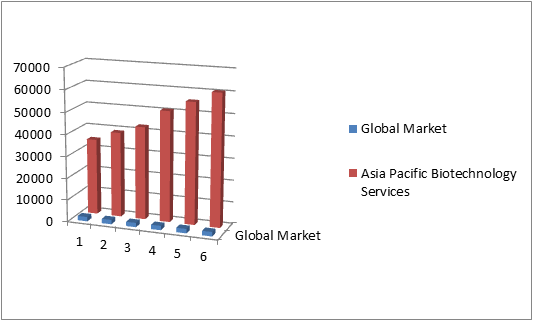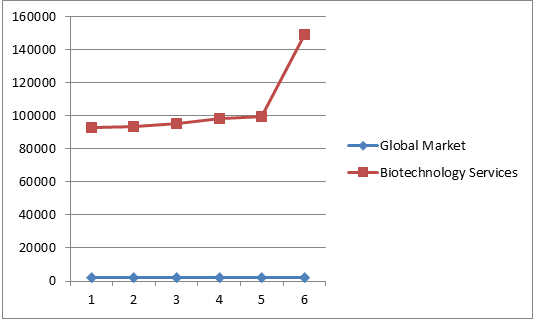Recommended Global Biotechnology Webinars & Conferences
Asia Pacific & Middle East
Canada
BIOTECH ASIA PACIFIC 2025
About Conference
Biotech Asia Pacific 2025 propose a gregarious invite to all the Directors, Deans, Heads, Scientists, Professors, Speakers, Research professionals and especially including attendees, speakers, exhibitors and sponsors from all over the world to involve in this prestigious event named with its series as “31stAsia Pacific Biotechnology Congress" that is going to be held on April 10-11, 2025 in Dubai, UAE.
Objective:
Biotech Asia Pacific 2025 is a platform to achieve the prevailing gaps in the transformation of this multidisciplinary science of hope, to serve promptly with solutions to all in the need. Biotechnology Congress 2025 will have anticipated participation of 120+ delegates across the world to discuss the purpose of the conference.
Biotech Asia Pacific 2025 unites people who have an enthusiasm for various fields of Advanced Biotechnology. Target Audience will be workforce from both mechanical and scholastic fields which incorporate; Professors, researchers, CEOs, Directors, Vice Presidents, Co-executive, Biotechnologists, Managing Directors, Industry Safety Officers, Environmental and Plant Scientists, Doctorates, Professors, Post Doctorate Fellows, Vendors of Consumer Products/Managers, Pharmaceutical Scientists, Students from the related fields.
Why Attend???
Biotech Asia Pacific 2025 gives a worldwide stage to trading thoughts and makes us overhauled about the most recent advancements in the field of Vaccine, Immunization and Vaccination. The chance to go to the presentations conveyed by Eminent Scientists from everywhere throughout the world.
Target Audience:
- Eminent personalities
- Directors/Managers
- Head of Departmental
- Presidents/Vice Presidents
- CEO's of biotech companies
- Professors, Associate and Assistant professors
- Doctors
- Research Scholars and students from the related fields
- Other experts in Vaccines
Sessions & Tracks
Track 1: Biotechnology
Industrial biotechnology is that the appliance of biotechnology for industrial functions, along with industrial fermentation. The exploitation of cells like micro-organisms, or elements of cells like enzymes, to get industrially helpful product in sectors like chemicals, food and feed, detergents, paper and pulp, textiles and biofuels. Industrial Biotechnology offers a premier forum bridging basic analysis, Research and Development with later-stage development for property bio based industrial and environmental applications. An increasing vary of chemicals and materials, like base chemicals, polymers, industrial catalysts, enzymes and detergents unit created exploitation biotechnology.
- Spectroscopies
- Protecting Research and Innovation in Industrial Biotechnology
- Bio-functionalized Nanoparticles
- Biomass and Feedstock Utilization
- Gene therapy more..
Track 2: Pharmaceutical Biotechnology
Pharmaceutical Biotechnology is that the science that covers all technologies needed for manufacturing, producing and registration of biological medicine. Pharmaceutical Biotechnology is associate more and more necessary space of science and technology. It contributes in style and delivery of latest therapeutic medicine, diagnostic agents for medical tests, and in cistron medical care for correcting the medical symptoms of hereditary diseases. The Pharmaceutical Biotechnology is wide unfold, starting from several moral problems to changes in aid practices and a major contribution to the event of financial set-up. Biopharmaceuticals consists of large biological molecules which are proteins. They target the underlying mechanisms and pathways of a disease or ailment; it is a relatively young industry. They can alter targets in humans that don't seem to be accessible with ancient medicines.
- Pharmaceutical Process and Quality Control
- Biopharmaceutical Regulations and Validations
- Biologics and Biosimilars
- Biomarker Discovery
- Pharmaceutical products of DNA Technology more..
Track 3: Plant and Agriculture Biotechnology
Biotechnology has been practiced for a protracted time, as folks have sought-after to boost agriculturally necessary organisms selectively and breeding. An example of ancient agricultural biotechnology is that the development of illness-resistant wheat varieties by cross-breeding totally different wheat sorts till the specified disease resistance was gift during a ensuing new selection. Genetic engineering technologies will facilitate to boost health conditions in less developed countries. Genetic engineering may end up in improved keeping properties to create transport of recent manufacture easier, giving customers access to nutritionally valuable whole foods and preventing decay, damage, and loss of nutrients. Benefits of Agriculture Biotechnology embrace multiplied crop productivity, increased crop protection, enhancements in food process, Improved nutritionary price, Environmental advantages, higher flavor, freshman manufacture. Biotechnology is outlined as a collection of tools that uses living organisms (or elements of organisms) to create or modify a product, improve plants, trees or animals, or develop microorganisms for specific uses.
- Plant tissue culture
- Tissue culture media
- Genetic engineering of plants
- Applications of transgenic plants
- Transgenic plants as bioreactors
- Plant Tissue Culture Techniques
- GM crops
- Horticulture
Track 4: Stem Cell Biotechnology
Stem cell biotechnology may be a revolutionary sub field of biotechnology to develop and improve tools and generate a lot of on through modify and regenerative drugs somatic cell technology is vital role in tissue regeneration drugs the idea for cell transplantation is that blood cells (red cells, white cells and platelets) and immune cells (lymphocytes) arise from the stem cells, that are gift in marrow, peripheral blood and twine blood. Intense medical care or medical care kills the patient's stem cells. This stops the stem cells from making enough blood and immune cells.
- Stem Cell Niche
- Adult Stem Cells
- Cancer Stem Cell
- Stem Cell Therapy
- Stem Cell Transplantation
- Induced Pluripotent Cells
- Embryonic Stem Cells
Track 5: Microbial/Industrial biotechnology
White or industrial biotechnology uses enzymes and micro-organisms to make bio based products in sectors such as chemicals, food and feed, detergents, paper and pulp, textiles and bioenergy. The application of industrial biotechnology has been proven to make significant contributions towards mitigating the impacts of climate change in these and other sectors. In addition to environmental edges, biotechnology will improve industry’s performance and products price and, because the technology develops and matures, white biotechnology can yield a lot of and a lot of viable solutions for our environment. These innovative solutions bring side edges for each our climate and our economy.
- Bioprocess/Fermentation Technology
- Downstream processing
- Enzyme Technology
- Biotransformation
- Microbial mining and Metal biotechnology
Track 6: Pain Medication
Prostaglandins are a group of lipid compounds that are delivered by the cells of the body and have a few vital capacities. They promote inflammation necessary for healing and also results in pain and fewer. Prostaglandins support the blood clotting function of platelets and protect lining of stomach and are created inside the body's cells by the compound cyclooxygenase (COX). There are two COX catalysts, COX-1 and COX-2. The two proteins deliver prostaglandins that advance aggravation, agony, and fever. Be that because it could, just COX-1 produces prostaglandins that help platelets and ensure the stomach. Non-steroidal anti-inflammatory drugs (NSAIDs) obstruct the COX compounds and decrease prostaglandins all through the body. As a result, continuous irritation, agony, and fever are diminished. Since the prostaglandins that secure the stomach and bolster platelets and blood coagulating likewise are diminished, NSAIDs can cause ulcers in the stomach.
- Opioids
- Adjuvants
- Lidocaine patches
- Corticosteroids
- Antidepressants
- Anticonvulsants
- Non-steroidal anti-inflammatory drugs
- Over-the-counter pain Relievers
- Narcotic pain medications
- Non-narcotic pain medications
Track 7: Medical Biotechnology
Medical biotechnology refers to a healthful or diagnostic product or a vaccinum that consists of or has been created in living organisms and will be factory-made via recombinant. Medical Biotechnology contains a tremendous impact on meeting the wants of patients and their families because it not solely encompasses medicines and medical specialty that ar factory-made employing a biotechnological process, however conjointly factor and cell therapies and tissue designed product. Today, the bulk of innovative medicines, whether or not factory-made mistreatment biotechnology or via a chemical synthesis sort of a ancient little molecule drugs, also as several diagnostic product, are made available by applying fashionable biotechnology in their development and producing.
- Tissue engineering & regenerative medicine
- Pharmacogenomics
- Biomedical Innovations
- Monoclonal Antibodies
- Viral Vector Manufacturing for Gene Therapies
Track 8: Environmental Biotechnology
Biotechnology is applied and used to study the natural environment. Environmental biotechnology might additionally imply that one attempt to harness process for business uses and exploitation. Environmental biotechnology as "the development, use and regulation of biological systems for correction of contaminated environments and for environment-friendly processes (green manufacturing technologies and property development). Environmental biotechnology will merely be delineated as "the best use of nature, within the style of plants, animals, bacteria, fungi and alga, to supply renewable energy, food and nutrients in a very synergistic integrated cycle of profit creating methods wherever the waste of every process becomes the feedstock for an additional process".
- Biodegradation and Bioremediation
- Water pollution and waste product
- Air pollution and control
- Air pollution and management
- Environmental Pollution
- Bioremediation & Biodegradation
- Biotechnology in restoration of degraded lands
- Biotechnology for site reclamation
- Biotechnology for treatment of business effluents
- Global environmental issues
Track 9: Nano Biotechnology
Nano biotechnology refers to the intersection of nanotechnology and biology. Given that the subject is one that has only emerged very recently, Bio nanotechnology and Nano biotechnology serve as blanket terms for various related technologies. The most vital objectives that square measure oftentimes found in Nano biology involve applying Nano tools to relevant medical/biological issues and processing these applications. Developing new tools, such as peptoid Nano-sheets, for medical and biological purposes is another primary objective in nanotechnology.
- Nano-biosensors
- Nano carrier-formulations
- Protein-based Nanostructures
- DNA-based Nanostructures
- Bioconjucated Silica Particles
- Bioeconomy Challenges for EU Regions
- Advances in Nano biotechnology
Track 10: Biotechnology and Bioprocess Engineering
Bioprocess Engineering combines biotechnology and engineering for the producing of materials from renewable feed stocks. This field includes basic bio-molecular analysis on proteins, enzymes and microbes, still as work on biosensors, bio-separations and bioreactors. Applications embody food process and preservation; pharmaceutical, nutraceutical and sweetener production; air and waste matter treatment; bio-based structural motifs for supramolecular architectures; microfluidics for bioreactors and DNA chips; bioenergy; and applications in the pulp and paper industry. There square measure natural links to medicine applications, like drug metabolism, tissue engineering and bio-based therapeutic treatments.
- Biomolecular Engineering
- Biocatalysis & Biotransformation
- Biosynthesis and Metabolic Engineering
- Bioseparation and Biopurification Engineering
- Bioprocess Control and System Engineering
- Biosensor and Bioelectronics
- Cell Culture Engineering
- Tissue Bioprinting
Track 11: Systems and Synthetic Biotechnology
Systems and artificial Biotechnology could be a comparatively new field in medicine analysis. It focuses on engineering new or changed sign proteins to make desired sign pathways within the cell. each living cell is a very advanced machine expressing thousands of various proteins. because of excellent regulation, many cells, like photoreceptors and alternative neurons in vertebrates, will live for many years. Cells also can self-reproduce by division, wherever each girl cells square measure utterly viable. selection (the “blind watchmaker”, to use Dawkins’ expression) spent many voluminous year to attain this perfection. because of elucidation of the intricacies of cellular restrictive mechanisms we will currently play evolution on our time scale: re-design proteins and sign pathways to attain our ends.Systems and artificial Biology could be a novel field that finds its origin at the intersection of biology and engineering. It involves coming up with and construction of biological systems or devices which will be applied in varied domains to induce given results. It’s a multidisciplinary effort created by scientists to know the functioning of biological organisms, cells & genes associate degreed implementation of artificial genetic processes to relinquish specific characteristics to an organism. It will even be accustomed develop a totally new biological system.
- Genome Construction, redaction and style
- Production of Natural product and alternative little Biomolecules
- Synthetic Biology Tools for enabling sure engineering science
- Artificial Systems for Biomolecule Production and Pathway Prototyping
- Laboratory Automation and AI for artificial Biology and Biosystems Engineering
- knowledge Integration and Data Management for Systems and artificial Biology
Track 12: Food biotechnology
Food biotechnology is being used to reinforce nutrition, enhance food safety and quality, and protect food crops and animals from diseases which will otherwise threaten our stable, affordable, and wholesome food provide. Biotechnology contains a role to play in making certain that safe and lush food is made on existing farm land to satisfy the increasing desires of the world’s growing population.
- Food Processing and Preservation
- Food Quality Standards
- Food Microbiology
- Food Additives
- Food Packaging
- Dairy technology
- Fermentation
Track 13: Oncolytic Biotechnology
Oncolytic Biotechnology is that the study of oncolytic virus, the virus that preferentially infects and kills cancer cells. As the infected cancer cells unit destroyed by oncolysis, they undo new infectious virus particles or virions to assist destroy the remaining growth. Oncolytic viruses area unit thought not solely to cause direct destruction of the tumor cells, however conjointly to stimulate host anti-tumour immune responses.
Track 14: Biomass and Bioenergy
Bioenergy is that the energy contained in organic matter (biomass) which may be reborn into energy forms that we will use directly, like electricity, heat and liquid fuel. Biomass is any organic matter of recently living plant or animal origin. Unlike coal, the organic matter is not fossilised. Traditionally within the main woody biomass has been used for bioenergy; however newer technologies have distended the potential resources to those like agricultural residues, oilseeds and algae. These advanced bioenergy technologies afford the property development of the bioenergy trade, while not competitive with the standard agricultural trade for land and resources.
- Economic Aspects of Biomass and Bioenergy
- Sustainability and Biodiversity Issues
- Sources of Biomass
- Biological Residues
- Bioenergy Processes
- Bioenergy Utilization
Track 15: Animal biotechnology
Animal biotechnology could be a immense field of study and includes the subsequent topics: use of animals in analysis clones transgenic animals and factor pharming animal health along side the scientific study, researchers should conjointly influence several powerful scientific and moral challenges. Animals play a vital role in primary research. The use of animal models permits additional fast assessment of the consequences of latest medical treatments and alternative product. Computer models and in vitro studies of cell cultures square measure usually used as supplements to animal analysis, however they can not entirely duplicate the ends up in living organisms. Trials square measure needed on cell cultures, in live animals, and on human subjects. Testing on live animal models needs that 2 or additional species be used as a result of completely different effects square measure determined in numerous animals.
- Animal cell culture
- Cell viability and cytotoxicity
- Cell transformation and cloning
- Organ and tissue engineering
- Transgenic animals
Market Analysis
The field of biotechnology is vast and has its own unique significance and necessity. Biotechnology is a field of technology or a collection of techniques based on biology; it uses cellular and biomolecular processes to create goods and technologies that enhance our quality of life and health. It entails the molecular and genetic modification of living things in order to enhance safety, nourishment, and the environment. By utilising nature's own toolkit and employing our own genetic make-up to treat hereditary illnesses, biotechnology is assisting in the healing of the globe.
Asia Pacific Biotechnology Services Market Report
With a compound annual growth rate (CAGR) of 9.2%, the Asia Pacific biotechnology services market increased from $22,407.8 million in 2016 to $34,755.3 million in 2021. At a compound annual growth rate (CAGR) of 11.7%, the Asia Pacific biotechnology services market is anticipated to increase from $34,755.3 million in 2021 to $60,524.7 million in 2026.
The Business Research Company's Asia Pacific Biotechnology Services Market Report 2023 discusses the market's characteristics, size and growth, trends, and strategies.
Global Biotechnology Services Market Report
With a compound annual growth rate (CAGR) of 7.9%, the global market for biotechnology services increased from $63,241.0 million in 2016 to $92,560.8 million in 2021. At a compound annual growth rate (CAGR) of 10.0%, the global market for biotechnology services is anticipated to increase from $92,560.8 million in 2021 to $149,164.7 million in 2026.
The Business Research Company's Global Biotechnology Services Market Report 2022 discusses the market's characteristics, size and growth, trends, and strategies. The report's section on market characteristics describes and defines the market. The market size section provides market revenues for Biotechnology Services, accounting for both past market expansion and future projections. The section on trends and strategies describes potential developments in the market for biotechnology services and makes recommendations.
To Collaborate Scientific Professionals around the World
Conference Date April 10-11, 2025
For Sponsors & Exhibitors
Speaker Opportunity
Useful Links
Supported By
All accepted abstracts will be published in respective Conference Series International Journals.
Abstracts will be provided with Digital Object Identifier by




